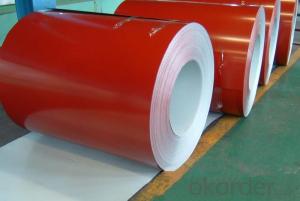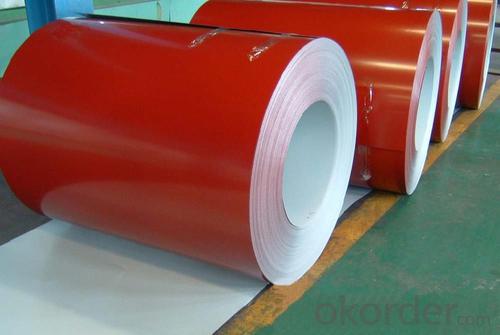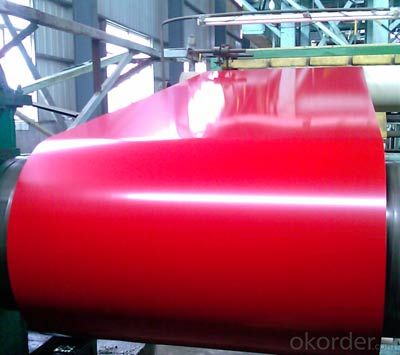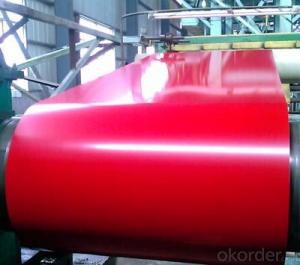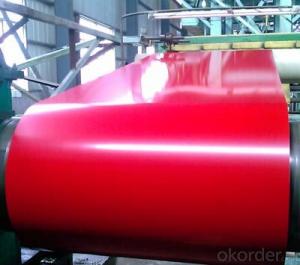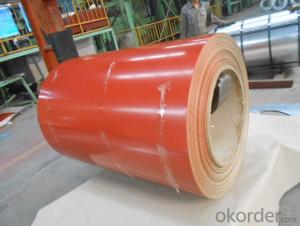Pre-painted Galvanized/Aluzinc Steel Sheet Coil with Prime Quality Red Color
- Loading Port:
- Shanghai
- Payment Terms:
- TT OR LC
- Min Order Qty:
- 100 m.t.
- Supply Capability:
- 10000 m.t./month
OKorder Service Pledge
OKorder Financial Service
You Might Also Like
1.Pre-Painted Galvanized/Aluzinc Steel Coil Description:
Pre-painted Galvanized/Aluzinc Steel Coil with GI or Aluzinc as base metal.
2.Main Features of the Pre-Painted Galvanized/Aluzinc Steel Coil
• High manufacturing accuracy
• High strength
• Good capable of decoration
• Superior workability
3.Detail Images of Pre-Painted Galvanized Steel Coil
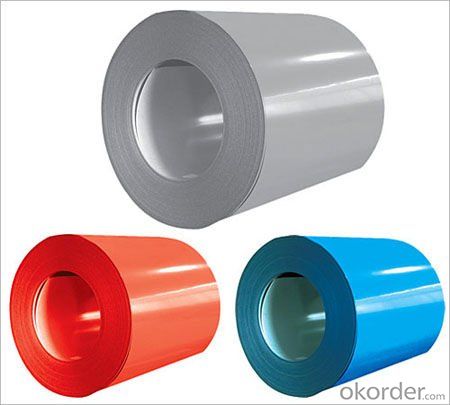

4.Specification of PPGI / GI Steel Sheet/Coil
1) AVAILABLE DESIGNATION OF PPGI/PPGL Prepainted Galvanized/Galvalume Steel Coils
Quality | Q/BQB 440-2003 | JIS G3312-1994 | EN 10326-2004 | ASTM A653-02a |
EN 10327-2004 | (BASE PLATE) | |||
(BASE PLATE) | ||||
Commercial Steel | TDC51D | CGCC | DX51D+Z/AZ | CS Type A/B/C |
Forming Steel | (TSt01,TSt02,TSt03) | CGCD1 | FS Type A, Type B | |
Drawing | TDC52D /TDC53D | - | DX52D+Z/AZ | DDS TYPE A/C |
Steel | DX53D+Z/AZ | |||
Structural | TS280GD(TStE28) | CGC400 | S280D+Z/AZ | SS275 |
Steel | TS350GD(TStE34) | CGC440 | S350D+Z/AZ | SS340 Class1 |
5.FAQ
1. What’s the application of this product?
Roof, roof structure, surface sheet of balcony, frame of window, etc.
- Q: How are steel coils transported and stored?
- Steel coils are typically transported and stored using specialized equipment and facilities. They are commonly transported by trucks, trains, or ships, secured with steel strapping or wire rope to prevent movement during transit. Once at the storage facility, steel coils are typically stacked in a secure and organized manner, either on the ground or on specially designed racks. The coils may be stored indoors or outdoors, depending on the specific requirements and conditions. To protect the coils from damage and corrosion, appropriate weather protection measures and coatings are applied.
- Q: How are steel coils used in the manufacturing of structural components?
- Steel coils are used in the manufacturing of structural components by being processed and formed into various shapes such as beams, columns, and plates. These coils are first uncoiled and then cut into desired lengths before being shaped and welded together to create strong and durable structural components used in buildings, bridges, and other infrastructure projects.
- Q: What are the major global steel coil markets?
- The major global steel coil markets are primarily concentrated in regions with significant industrial and manufacturing sectors. Some of the key markets include North America, Europe, and Asia-Pacific. North America, particularly the United States, is a major steel coil market due to its large automotive industry and construction sector. The demand for steel coil in this region is driven by the production of automobiles, infrastructure development, and residential construction. Europe is another significant market for steel coil, with countries like Germany, Italy, and France being major consumers. The automotive industry, construction sector, and machinery manufacturing contribute to the demand for steel coil in this region. Asia-Pacific, specifically China, is the largest market for steel coil globally. China's booming economy, rapid urbanization, and infrastructure development have led to a massive demand for steel coil. Other countries in the region, such as Japan, South Korea, and India, also have substantial steel coil markets due to their industrial and construction activities. Additionally, emerging markets in Latin America, the Middle East, and Africa are witnessing increasing demand for steel coil. These regions are experiencing economic growth and urbanization, leading to a rise in construction and infrastructure projects. Overall, the major global steel coil markets are driven by industrial and manufacturing activities, infrastructure development, and construction projects in various regions around the world.
- Q: How are steel coils used in the manufacturing of automotive chassis?
- Steel coils are used in the manufacturing of automotive chassis as they provide the necessary strength and durability required to support the weight of the vehicle and withstand various stresses and impacts. These coils are processed and formed into various structural components, such as frame rails and cross members, which form the foundation of the chassis.
- Q: How would you calculate the maximum plastic deformation (expansion) a steel pipe can handle before it actually fails?
- You can calculate the maximum reversible strain, for elastic loading as follows: You need to look up the yield strength (for that particular type of steel). Divide this yield strength by the elastic modulus of steel (also called Young's modulus). That gives you the strain at the onset of yielding, the maximum you can strain the steel fibers before crossing the point of no return. If you are interested in the strain until failure, you need to take tensile test measurements. Seldom do people document an equation to model the non-elastic portion of the stress-strain curve of the specimen, because seldom do we design systems to operate with materials which yield. We want systems which only deform reversibly and elastically. This means you need to perform an experiment to find what you are actually desiring to know.
- Q: How are steel coils inspected for edge quality using visual inspection?
- To ensure that steel coils meet the necessary standards and specifications, visual inspection methods are employed to assess their edge quality. This involves carefully examining the edges of the coils to identify any defects or imperfections that may have occurred during manufacturing or handling. During this inspection process, trained inspectors visually assess the edges of the steel coils for various parameters, such as burrs, cracks, unevenness, roughness, and other irregularities that could impact the steel's quality and performance. To conduct these assessments, they utilize specialized tools like magnifying glasses, microscopes, or cameras to closely observe and analyze the edges. Each coil is meticulously inspected by the inspectors to detect any signs of defects that could potentially affect the steel's functionality or integrity. They pay meticulous attention to detail, ensuring that the edges are smooth, devoid of sharp edges or protrusions, and possess consistent dimensions throughout the coil. Apart from visual inspection, inspectors may also employ specific testing methods like dye penetrant testing or ultrasonic testing to further evaluate the quality of the steel coil edges. These supplementary tests aid in detecting any hidden defects that may not be visible to the naked eye. As a whole, visual inspection plays a vital role in the quality control process for steel coils by allowing for the identification and elimination of edge defects that could compromise the steel's performance and durability. By ensuring that the edges meet the required standards, visual inspection helps to uphold the quality and dependability of the steel coils.
- Q: What is the process of galvanizing steel coils?
- The process of galvanizing steel coils involves several steps to enhance their durability and protect them from corrosion. Firstly, the steel coils are cleaned thoroughly to remove any dirt, oil, or other impurities that may be present on the surface. This is done through an acid pickling process, where the coils are immersed in a bath of diluted acid solution or treated with a chemical cleaner. This step ensures that the surface of the coils is free from any contaminants, allowing for better adhesion of the zinc coating. After the cleaning process, the coils are rinsed to remove any remaining acid or cleaner. This is crucial to prevent any adverse reactions with the next step of the process. The next step is the actual galvanization, where the cleaned coils are dipped into a bath of molten zinc. The coils are carefully passed through the zinc bath using rollers or other mechanisms to ensure that the entire surface is coated evenly. The zinc bath is maintained at a specific temperature, typically around 450°C (842°F), which allows the molten zinc to bond with the steel surface. As the coils are withdrawn from the zinc bath, excess zinc is removed by passing them through air knives or by centrifugal spinning. This helps to control the thickness of the zinc coating and ensure a uniform appearance. Once the galvanization process is complete, the steel coils are cooled down gradually to room temperature. This allows the zinc coating to solidify and bond firmly with the steel surface, creating a protective barrier against corrosion. The final step in the process is inspection and quality control. The galvanized steel coils are inspected for any defects, such as uneven coating or areas with insufficient zinc coverage. This is usually done visually or through specialized equipment that can detect any anomalies. Additionally, the coating thickness is measured to ensure it meets the required specifications. Overall, the process of galvanizing steel coils is designed to enhance their longevity and protect them from rust and corrosion. By applying a layer of zinc coating to the steel surface, the coils become more resistant to environmental factors, making them suitable for a wide range of applications in various industries.
- Q: In the warehouse management system of steel coil
- Warehouse is an important component of enterprise material supply system. It is also the tache of enterprise material circulation and storage, and it also undertakes many functions of material management. Its main tasks are to keep the stock well, to be accurate, to be of good quality, to ensure safety, to prompt the people, to produce, to be considerate, to reduce costs, and to speed up capital turnover.
- Q: How are steel coils used in the manufacturing of furniture?
- Steel coils are commonly used in the manufacturing of furniture as they provide structural support and stability. They are typically used in the construction of sofa frames, mattress foundations, and other furniture pieces that require strength and durability. The coils are often incorporated into the furniture's framework or used as a base for cushions and upholstery, ensuring long-lasting and comfortable products.
- Q: I am trying to clean up a stainless steel back splash and some kitchen appliances that have brown spots that look like rust spots. I was able to remove most of them with stainless steel cleaner but does anyone know any tricks?
- I recommend using a product called Bar Keepers Friend. It is a household powder cleaner like Ajax but it has a mild abrasive that works on stainless steel and other surfaces. It will remove the rust without harming the stainless steel.
Send your message to us
Pre-painted Galvanized/Aluzinc Steel Sheet Coil with Prime Quality Red Color
- Loading Port:
- Shanghai
- Payment Terms:
- TT OR LC
- Min Order Qty:
- 100 m.t.
- Supply Capability:
- 10000 m.t./month
OKorder Service Pledge
OKorder Financial Service
Similar products
Hot products
Hot Searches
Related keywords
